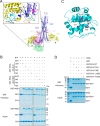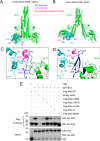Mechanism of vaccinia viral protein B14-mediated inhibition of IκB kinase β activation
- PMID: 29748387
- PMCID: PMC6028965
- DOI: 10.1074/jbc.RA118.002817
Mechanism of vaccinia viral protein B14-mediated inhibition of IκB kinase β activation
Abstract
Activation of IκB kinase β (IKKβ) is a central event in the NF-κB-mediated canonical pro-inflammatory pathway. Numerous studies have reported that oligomerization-mediated trans autophosphorylation of IKKβ is indispensable for its phosphorylation, leading to its activation and IKKβ-mediated phosphorylation of substrates such as IκB proteins. Moreover, IKKβ's interaction with the NF-κB essential modifier (NEMO) is necessary for IKKβ activation. Interestingly, some viruses encode virulence factors that target IKKβ to inhibit NF-κB-mediated antiviral immune responses. One of these factors is the vaccinia viral protein B14, which directly interacts with and inhibits IKKβ. Here we mapped the interaction interface on the B14 and IKKβ proteins. We observed that B14 binds to the junction of the kinase domain (KD) and scaffold and dimerization domain (SDD) of IKKβ. Molecular docking analyses identified key interface residues in both IKKβ and B14 that were further confirmed by mutational studies to promote binding of the two proteins. During trans autophosphorylation of protein kinases in the IKK complex, the activation segments of neighboring kinases need to transiently interact with each other's active sites, and we found that the B14-IKKβ interaction sterically hinders direct contact between the kinase domains of IKKβ in the IKK complex, containing IKKβ, IKKα, and NEMO in human cells. We conclude that binding of B14 to IKKβ prevents IKKβ trans autophosphorylation and activation, thereby inhibiting NF-κB signaling. Our study provides critical structural and mechanistic information for the design of potential therapeutic agents to target IKKβ activation for the management of inflammatory disorders.
Keywords: B14; IKKβ; autophosphorylation; inhibition mechanism; molecular docking; protein kinase; trans autophosphorylation; vaccinia virus; virus.
© 2018 Tang et al.
Conflict of interest statement
The authors declare that they have no conflicts of interest with the contents of this article. The content is solely the responsibility of the authors and does not necessarily represent the official views of the National Institutes of Health
Figures





References
Publication types
MeSH terms
Substances
Associated data
- Actions
- Actions
- Actions
Grants and funding
LinkOut - more resources
Full Text Sources
Other Literature Sources
Molecular Biology Databases
Miscellaneous

